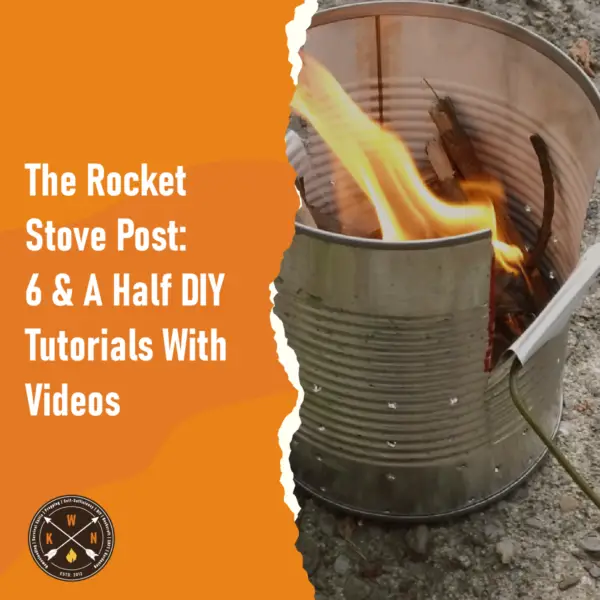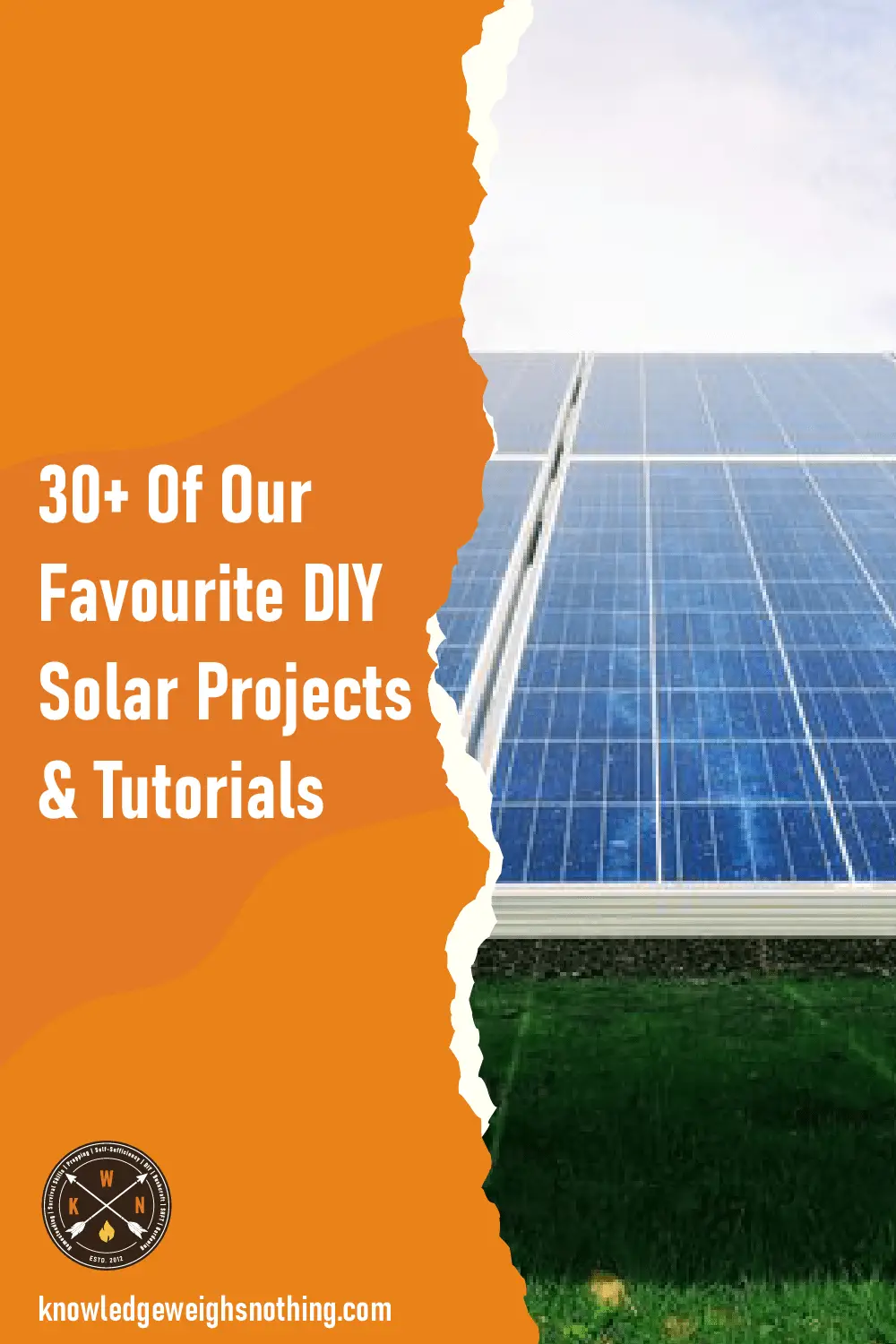
As you’ve arrived here, you will likely be well aware of the benefits of rocket stoves. If not, the bottom line is rocket stoves are extremely efficient stoves to cook with. They generate a huge amount of heat and require substantially less fuel to run. More heat from less fuel makes building a rocket stove an excellent option for anyone living off-the-grid, or for people that are concerned with emergency preparedness.
It seems that not a day goes by without a new DIY rocket stove tutorial appearing online. There are literally 100s of tutorials and videos! So, with so many about… How do you know where to look, and which rocket stoves to build? Well, within this guide you’ll find six (and a helpful half!) of the most popular rocket stoves you can make, complete with videos and written instructions.
BTW — If you are interested in small camping/hiking style stoves, check out our Folding Firebox stove review. It’s pretty heavy, but it folds down flat and it is absolutely bomb-proof… The Firebox stove will last you a lifetime.
Table of Contents
ToggleTutorial One: Tin Can Rocket Stove
Let’s start off with a fun tutorial that will come in handy should you ever find yourself somewhere unexpected with only a tin can and a few bits and pieces to cook with.
What you’ll need
- A can with a lid
- 2 large cans (theses should be of the 28 oz variety)
- A spare can
- A little insulation (your loft won’t miss it!)
- Tin snips (for cutting your cans and keeping those digits safe for the construction, cooking and eating stages!)
- A marker pen to mark the cans and where you should be cutting them
- A wire hanger (which makes the handle)
- High heat spray paint (if you want to go all out)
Cooking on a tin can: Step by Step
Step One – Mark and cut the centre hole within the large can
You should use the lid from the smaller of the cans to do this, placing the hole with its bottom edge around 5cm from the bottom of the larger can.
Once done, you can go ahead and cut the hole out (be sure to remember your goggles and gloves for safety). Once the hole is cut, you should check out whether the small can fits inside.
Step Two – Mark and cut a hole within the inner can
Repeat this process with the inner can. You can even use the cut out circle from the large can to guide your margin and cutting efforts.
Step Three – Cut and Insert the last can
Now it’s time for the last can. First, cut one rim off so that it is an open can at one end. Then, go ahead and cut 1.5 inch tabs around the rim. With this now flexible end, insert it into the other smaller can’s hole (be sure that this can is already within the larger of the cans).
Step Four – Cut a lid
With the lid from the largest can, cut out a hole that covers all of the area surrounding the smaller can within it.
Step Five – Fill you can with insulation
Now, fill the can with insulation so that the space between the larger and smaller inner can is completely topped up and packed down. You should then fold down four tabs on the larger can, using a hammer if you need a little help.
Step Six – Add a shelf
Now it’s time to add a mini shelf within the can that pokes outwards from the larger can. Simply cut a rectangle from the metal scraps that you have, cut around an inch into each side and slide the shelf into its place, finally folding down its flaps for a secure fit.
Step Seven – The finishing lick of paint
To finish off your now great looking rocket stove, you can spray paint it black (being sure that the paint is special high heat paint). You may also wish to add that hanger handle by drilling two holes either side of the top of the can.
Now you’re all done and ready to go, so pop those twigs in so that they rest on your shelf and light it up!
Tutorial One And A Half: The World’s Smallest Rocket Stove
Ok, so this tutorial may be considered as a variation of the first, which is why it’s numbered as one and a half. This step by step set of instructions follows all of the steps that the first one does, however it’s on an altogether smaller scale and so the materials are different.
What you’ll need
- Spray can for the larger of cans (such as a body spray can… however you must know how to cut these as they’re pressurised)
- The inner cans are made from piping (you may need to hunt around to get the dimensions right, and use a material that isn’t too thick or that poorly convects heat)
- Sand (this is in replacement for the insulation)
The World’s smallest rocket stove: Step by Step
Just follow all of the steps within tutorial one, but take a little more care as you’ll be working on a smaller scale. You can also skip the paint and handle step if you wish… this is really just for fun!
Tutorial Two: The DIY 6 Brick Dual Burner Rocket Stove
The first tutorial is perfect for those looking for something small and compact, but what if you want something more impressive, or that is capable of heating at least two pans at once? Well, luckily for you, we have a tutorial for a dual burning stove, and better yet, this tutorial requires just six bricks (as well as few other items as listed below) and a budget of $6!
What you’ll need
- Four double breeze blocks
- Two single breeze blocks
- Two metal mounts from a stove
The DIY Dual Burner: Step by Step
Step One – Place the bricks
First, you need to place the double breeze block bricks into a rectangular shape, with the two middle ones lying flat against one another, and the other two stood upright at either end.
Then add the last two single breeze blocks with their open ends pointing upwards.
It’s important that the upper double breeze block, which sits directly underneath the two single breeze blocks, is seated with its open end underneath (pointing upwards). The breeze block that is then underneath is the other way around, allowing for you to place your wood in without it dropping, and thereby allowing for the heat to rise up into the single blocks.
Step Two – Add your wood
Add your wood into the central breeze block, this is done through the side as you’ll place your end breeze blocks with their open ends outwards. This then means that there’s no need to move the upper stoves… you can simply side feed and go!
Step Three – That’s it!
That’s all there is to it, so stick some food on the stove and get cooking!
Tutorial Three: The Rocket Stove Water Heater
This is a heater that works on little fuel (which can be as simple as a few sticks) and is more efficient than your average household water heater. This stove can accept up to 200 liters of water.
What you’ll need
- 18 matters of copper pipe
- Oil barrel (44 gallons)
- Ceramic or stone structure to create the stove itself
The Rocket Stove Water Heater: Step by step
Step One – Wind your copper coil and create the drum structure
The copper pipe is coiled through an oil barrel, leading from your cold water supply and outputting a warm water supply. This will be placed at the top of the stove structure.
Step Two – Create the ceramic bed base
Now it’s time to create the outer structure that will house the copper drum and burning structure. This can be constructed from ceramic or stone bed base.
That’s all there is to it! There may be only two steps however, but the construction of the ceramic outer casing may take a considerable amount of time.
Tutorial Four: A Simple 16 Brick Rocket Stove
Brick rocket stoves seem to be the most popular variety, so I wanted to give you a little choice as to which you opt for. Here, we take a look at a DIY rocket stove project that consists of smaller house bricks and that similarly comes in at a budget busting total of just $6.
What you’ll need
- 16 bricks
- 3 Patio blocks
A brick rocket stove: Step by step
Step One – Layout your patio blocks
This is so you have a level bottom layer upon which to build your stove
Step Two – Add the first layer of bricks
This should consist of 4.5 bricks, where three are lined up horizontally, and the 1.5 bricks form the end.
Step Three – Add the second layer of bricks
Now you want to arrange the second layer a little differently, being sure to leave the middle section empty.
Step Four – Add the third layer
Now you can add the third layer, leaving only the middle empty.
Step five – Add the fourth and final layer
Add the final layer, replicating the third layer.
Step Six – Add a single brick to below the side hole
This will serve as your fuel feeder.
Step Seven – You’re all done
Now it’s time to feed the fire and get to cooking. The total build time of this particular stove is then less than 20 minutes. To finish off the fire so that you can warm water you simply add a metal grid, or a stove metal mount.
Tutorial Five: The single-pot rocket stove
For those looking for a rocket stove that can accommodate a large vat or liquid with ease, this single-pot rocket stove tutorial is perfect. What’s more, with materials that should be readily available, and a design that is based upon an insulated rocket reflow combustion chamber to increase combustion and reduce smoke, this is one tutorial that features easily sourced materials, easy to follow instructions and a stove that provides superior performance.
It has much in common with many of the other tutorials that you’ll find here however, as only the tips of the wood burn, thus allowing for optimal performance. So then, now that you’re sold on the idea, let’s get started.
What you’ll need
- Sheet metal or a 5 litre metal can
- Water, Clay, Sawdust – To make the light weight bricks required for the inner structure
- Wooden Mold
- One reasonably sized clay brick
- Vermiculite or perlite
- Cement
The single-pot rocket stove: Step by Step
Step One – Create your light weight bricks from the Water, Clay and Sawdust
The light weight bricks that make up the inner combustible stove are perfect for a rocket stove as they have better draft and higher combustion temperatures, which decreases the emission from burning biomass.
To make them you mix the clay and sawdust first, kneading the sawdust and clay together; once well mixed add in the water gradually and continue to mix the ingredients. You should stop adding water when the consistency is rough, relatively stiff and without lumps.
The recipe will need to be fine-tuned as according to the sawdust that you are using. However generally speaking the following measurements tend to work well with most sawdust types.
- 500g Sawdust
- 1200g Water
- 900g Clay
The bricks should be fired at around 1000 Celsius, which should create bricks with an optimum density of 0.6g/cc (perfect for our purposes, and at this density the bricks themselves will float in water).
You will need to create a wooden mould to shape your bricks (and wet the wood so that they slip out of the bottom easily). The brick is removed later once the consistency has hardened.
Step Two – Create the combustion chamber
Once all of your bricks are ready it’s time to begin work on the combustion chamber. This should begin by two clay bricks being placed adjacent to one another, with a normal, heavier brick between them placed at what will be the back of the chamber. This creates a ‘U’ shape.
Build up the chamber from here by adding three levels of brick total with no openings (this brings your chamber to around 30cm high).
Step Three – Add the cylinder by placing it over the combustion chamber
The sheet metal cylinder has a square hole cut into the bottom, do that it lines up with the entrance of the combustion chamber. For now you can temporarily fill up the cylinder’s entrance with a brick.
Step Four – Add the cement between the cylinder and the combustion camber
Fill up your cylinder with cement, leaving the middle section within the combustion chamber open.
Step Five – Add three metal bars in a triangle shape
Adding three metal bars into your cylinder can serve as a built in pot rest. To make these secure you can drill six holes in total into the cylinder, ready to accept the melt bars. This metal to metal contact upon which your pot will be placed additionally benefits from the natural convection of the sheet metal. Just be sure to leave a 12mm gap between the metal bars and the combustion chamber.
Step Six – Consider a pot skirt for super quick cooking
To make your rocket stove even more efficient you can add a stove skirt, which simple lengthens the height of the metal cylinder, allowing for the heat to run past the sides of the pot.
Tutorial Six: Rocket Stove For Indoor Heating
(There is no video for this rocket stove, but click here is the original blog post with full instructions.)
This final tutorial is for those who may be more advanced with DIY skills, as well as being pretty handy with a welding torch. It creates an impressive indoor rocket stove that looks more akin to a home heating system.
What you’ll need
- An old electric hot water tank (or, for an easy life you may consider using a steel drum)
- 3″ diameter steel pipe
- 4″x4″ square tubing
- Flat steel plate
* All of the above each had around 1/8″ wall thickness, which may be thicker than necessary.
- Flexible Aluminium tubing (e.g. dryer ducking)
The ultimate rocket stove for indoor heating: Step by Step
Step One – Attach the dryer ducting to a chimney for testing purposes
Step Two – Cut the water tank tube so it is able to accept the combusted chamber and chimney
The chimney should already have a square end that is welded on, which will be the part inserted into the hot water tank
Step Three – Weld the chimney into the inside of the hot water tank
Before being able to do this, you’ll obviously need to cut the end off of the tank. You can also place a block of wood underneath the chimney to keep it in place for welding.
Step Four – Once the welding is complete and cooled you can spray your tank
If you do spray your tank use black, as this absorbs and retains heat better. You should also ensure that you’re using a high heat performance spray paint.
Step Five – Weld the lid back on
You can cover over any messy welding with a nice silver sheet metal ring.
Step Six – Attach the dryer ducting to the square that now juts out from the tank
Step Seven – You may finally want to think about adding a vented removable screen to the end of the combustion chamber
This will stop any sparks from flying off of the wood and into your room (this step is actually pretty essential).
If you enjoyed this post, you might be interested in our rocket mass heater post too!




